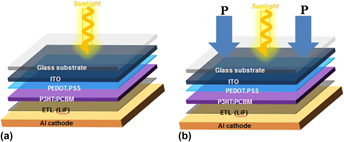Article contents
Effects of pressure on nano- and micro-scale morphological changes in conjugated polymer photovoltaic cells
Published online by Cambridge University Press: 29 September 2016
Abstract

This paper presents the results of an experimental study of the effects of pressure on polymer chain alignments in poly(3-hexylthiophene) and [6,6]-phenyl C61-butyric acid methyl ester (P3HT:PCBM) blends that are used in bulk heterojunction organic photovoltaic cells (OPVs). The P3HT:PCBM blends on glass were subjected to pressure and annealing at 140 °C. The surface morphologies, nano-/micro-structures and the chain alignments were analyzed using atomic force microscopy techniques and grazing incidence x-ray scattering. The current–voltage characteristics of the resulting devices are also shown to change significantly with changes in the nano-/micro-structures. The polymer chains were aligned in the direction of the applied pressure (edge-on), which reduced the lamellae spacing between the polymer units and increased the degree of crystallinity. The increased crystallinity plays significant role in the current–voltage enhancements. The implications of the study are discussed for the design and control of the nano/microstructures of bulk heterojunction organic solar cells.
Information
- Type
- Article
- Information
- Copyright
- Copyright © Materials Research Society 2016
References
REFERENCES
- 3
- Cited by


